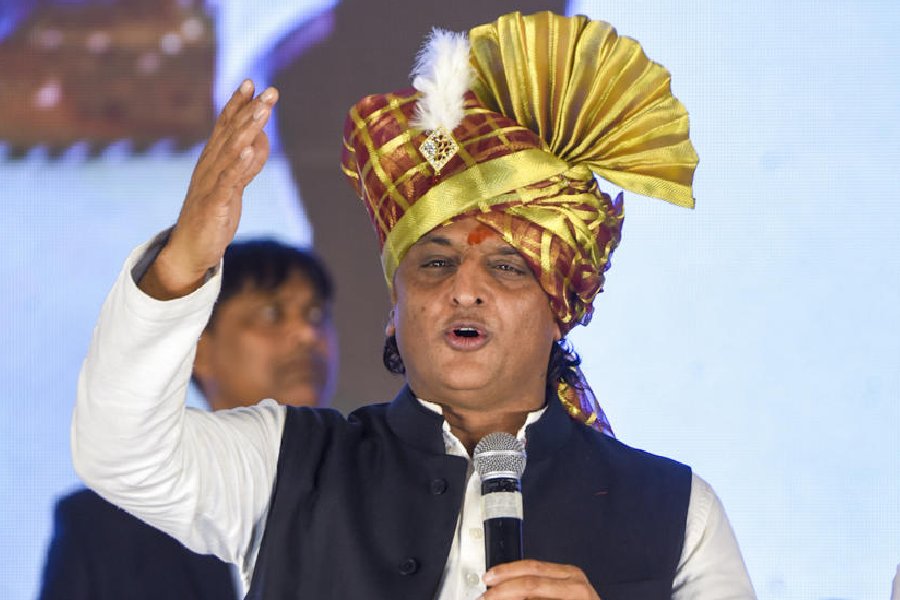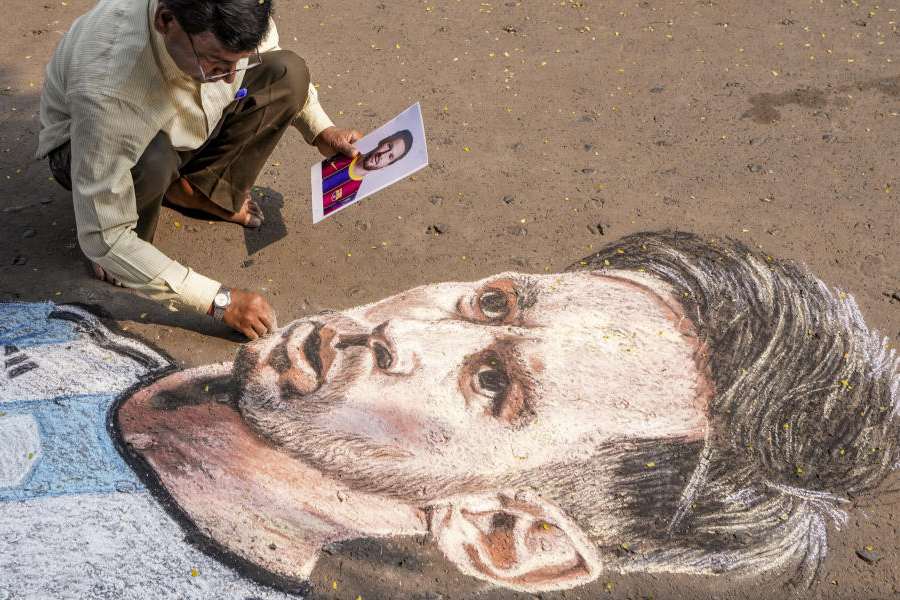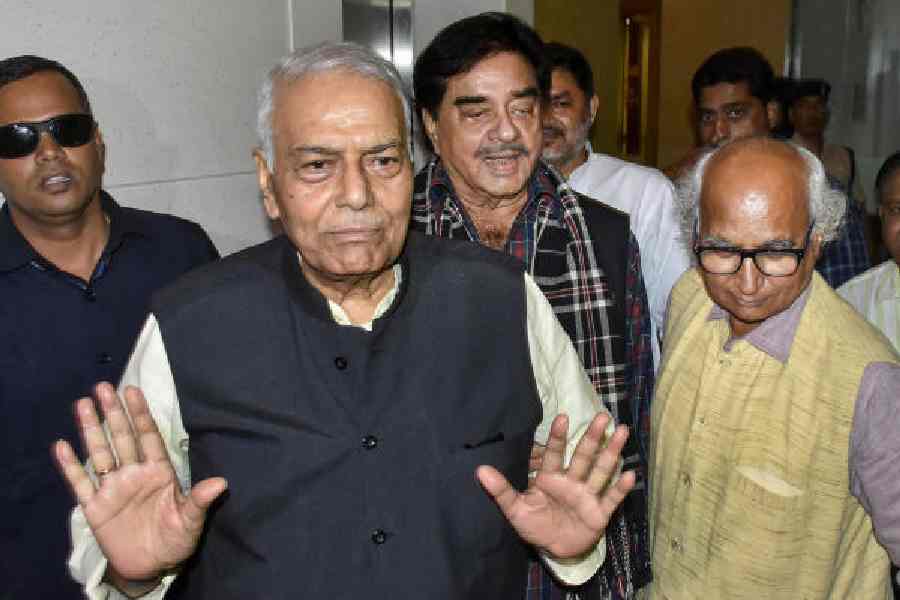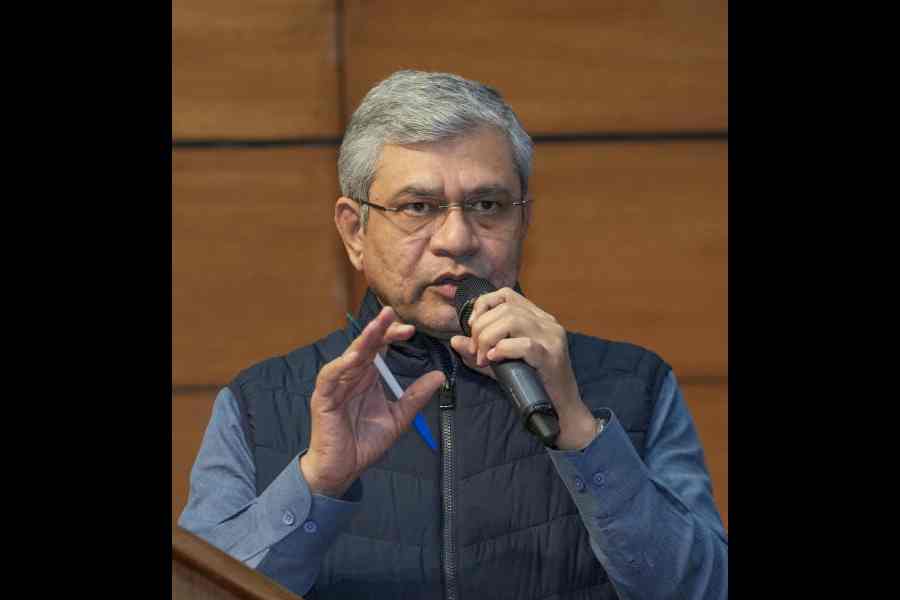 |
| Mukha Bhaona being performed at a satra. Picture by S.H. Patgiri |
Satra as an institution was established for spreading Bhagawati dharma among the masses. Srimanta Sankardev along with his disciples Sri Sri Damodardev, Sri Sri Haridev, Sri Sri Madhabdev, Gopaldev Ata, Bangshi Gopaldev, Kabiratna Vaikunthanath Bhattacharyya and others spread the Bhagawati religion among the masses through nine mediums — sravan, kirtan, bandan, smaran, padasewan, archan, dashya, sahitya, atmanivedam.
However, in the later parts, only sravan and kirtan were used as mediums for spreading the religion. The religion was known as the Bhagawati dharma or Sattriya Vaishnav dharma. Kirtan or nam being the fundamental aspects, this religion was also known as “Nam-dharma”.
After the salvation of Srimanta Sankardev, the Nava Vaishnav community of Assam was divided into four sects, or samhatis, namely Brahma, Kal, Nika and Purush. There is no major difference between these four samhatis in regard to fundamental views, decisions, customs and traditions. Differences can be observed only in the degree of importance given to Nam, Dev, Guru and Bhakta as also with respect to some other inconsequential customs of the satras.
Sri Sri Damodardev, Sri Sri Haridev and their disciples founded the Brahma Samhati satras. There is no marked difference between the Bhagawati Vaishnav dharma and the Brahma Samhati satras. As is the case with Bhagawati Vaishnav dharma, Sri Madbhagawat Gita is considered as the supreme religious book in the Brahma Samhati satras, too. However, idol worship is given importance and worship of five devas — Aditya, Devi, Rudra-Keshava or Ganesha, Bishnu, Shiva and Durga — is performed in such satras. Strong influence of Bhakta, Bhagawat, Guru and Murti is observed in Brahma Samhati satras.
The eldest grandson of Srimanta Sankardev, Purusottam Thakur, was the founder of the Purush Samhati satras.
Here, Srimanta Sankardev is accepted as the only guru and maximum importance is given to nam or kirtan.
According to Maheswar Neog, the Purush Samhati claims to have retained the original features of Sankardev’s faith and, therefore, insists to be the main samhati.
Gopaldev Ata was the founder of Kal Samhati satras. Kal Samhati gives importance to total surrender and devotion to guru and accepts him as its one and only God. In other satras, different idols of Bishnu can be found. But in Kal Samhati satras, there is no idol-worshipping. The bhakats (disciples) follow strict religious code in all aspects of their daily life. Use of flower garlands, offering of betel-nut and paan and decoration of the offerings are prohibited in Kal Samhati satras. Moreover, fruits are offered to God without cutting the tail and the head portion in contrast to the other satras and namghars. The offering to God is called saj.
Nika Samhati satras were set up by the disciples of Sri Sri Madhabdev, including Mathura Das Ata, Padma Ata, Keshab Ata and so on. Since these satras firmly believe in complete surrender to one God, adherence to strict discipline and stringent observance of pure and detached thought, they are known as Nika (pure) satras. But as observed in several Nika satras in recent times, the disciples have been found not observing the rules and codes of conduct expected of them.
Most of the important Vaishnavite satras such as Aauniati, Dakhinpat, Garmur, Kamalabari and Samaguri are located in the river island of Majuli. These are greatly threatened by periodic annual floods and already satras like Aauniati have been shifted to new locations and others satras threatened by floods are considering shifting their base from the island in the Brahmaputra.
Although nothing can compensate and restore the ambience and vibes of the satra in their original location, considering the threat of obliteration by perennial floods, gradual shifting of the endangered satras is the only practical solution, which needs to be pursued urgently.
The Aauniati Satra located in the Silsako region of North Guwahati was shifted from its original location at Majuli because of the havoc caused by floods. After the shifting of the satra, many of its earlier activities have ceased, including the regular enactment of Bhaona. A visit to the Aauniati Satra located at North Guwahati threw lights on some lesser-known aspects such as the functioning and activities of the satra and how shifting of the satra from its original location to a new urban environment can affect the mindset of the bhakats. During the course of the visit, interaction was made with the Keolia bhakats residing within the satra to gather first-hand information about their activities in a satra.
Although during earlier times, satras used to be abuzz with cultural activities, including crafts making and mask-making and training of Sankari art and culture, in the Aauniati Satra at Silsako, we did not encounter the same spurt of activities. The state of the Aauniati Satra of North Guwahati left us somewhat disappointed.
The Keolia bhakats lead an austere life. Apart from morning and evening prayers, they appeared to remain mostly idle and are not trained in Sankari art like Bhaona, Ojapali, Sattriya dance and so on unlike some of their counterparts in other satras.
During the post-Sankardev era, Satradhikars and Deka Satradhikars of Majuli satras and other important satras of Assam had written many religious books, songs, dramas and religious hymns. Satras located in Majuli possess some invaluable books, religious hymns, translated books, Charit Puthis and Sachipat Puthis written by Srimanta Sankardev, Sri Sri Madhabdev and their successors, which are kept in closets. Once in a while, these are put under the sun for protection from paper moth and fungus. But the efforts are not sufficient to prevent decay, which has already damaged some invaluable documents. During the recent devastating floods, many of the Sachipat and other valuable Puthis kept in the Majuli satras have been irreparably damaged. Unless efforts are not undertaken immediately to preserve these cultural treasures in a scientific way, it will vanish into oblivion.
The Aauniati Satra is constructing an archival museum for preserving the invaluable documents, books, satra chronicles, biographies (Charit Puthis), scripts, mukhas, Ariya, Agnigarh, and traditional items like barsarai, borsankha, borbati, bankahi, safura and oralmari, which are threatened by floods in Majuli (the original location).
Traditional items made from ivory, silver, cane and bamboo will also be conserved in the museum.
The museum, which is slated to be inaugurated in September this year, will fulfil a long-felt requirement towards preservation of Sattriya art and culture. The museum being centrally located, can enlighten the tourists visiting this region about Assam’s history as well as the Vaishnavite culture.










